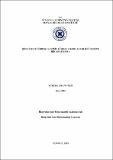DSpace Repository
İKİNCİ SINIF ÖĞRENCİLERİNİN GÖRSEL OKURYAZARLIĞI ÜZERİNE BİR ARAŞTIRMA
JavaScript is disabled for your browser. Some features of this site may not work without it.
| dc.contributor.author | Örs, Esra
|
|
| dc.date.accessioned | 2019-05-16T07:14:22Z | |
| dc.date.available | 2019-05-16T07:14:22Z | |
| dc.date.issued | 2015-07 | |
| dc.identifier.uri | http://hdl.handle.net/11547/1933 | |
| dc.description.abstract | Türkiye’de görsel okuryazarlık eğitimi incelendiğinde verilen eğitimin öğretmen kılavuz kitaplarında yer alan etkinliklerle sınırlı kaldığı ve görsellerin incelenmesinden öteye gitmediği görülmektedir. Son yıllarda önemi oldukça artan görsel okuryazarlık eğitiminin ülkemizde diğer ülkelere nazaran daha az kanıksandığı düşünülmektedir. Bu araştırmada Türkçe 1-5. Sınıflar Programında yer alan ilkokul 2. sınıf görsel okuma ve görsel sunu kazanımlarıyla ilgili etkinlikler hazırlanarak, öğrencilerin görsel okuryazarlığını geliştirmek ve sonuçlarını bilimsel ölçütlere göre açıklamak amaç edinilmiştir. Bu amaç doğrultusunda 2. sınıflarda geçerli olan görsel okuma ve görsel sunu kazanımlarına yönelik çoktan seçmeli test ve 16 adet etkinlik hazırlanarak eylem araştırması yaklaşımı doğrultusunda uygulanmıştır. Tez kapsamında hazırlanan tüm etkinlikler; öğretim programı, içerik, öğrenci düzeyi, dil ve anlatım bakımından araştırmacı ve uzmanlarca incelenerek son şekli verilmiştir. Çalışma dört bölüm, kaynakça ve eklerden oluşmaktadır. Bunlardan ilki kavramsal çerçevedir. Kavramsal çerçevede okuma ve okuryazarlık, görsel, görsel algı ve görsel okuryazarlığın ne olduğu incelenmiş; görsel okuryazarlığın Türkiye’de ve diğer ülkelerdeki tarihi gelişimine bakılmış; görsel okuryazarlığın medya okuryazarlığıyla ilişkisi ele alınmıştır. İkinci bölümde, araştırmanın amacı, önemi, problem cümlesi, çalışma grubu, veri toplama araçları ve verilerin analizi açıklanmıştır. Araştırma nitel araştırma yöntemlerinden eylem araştırması deseninde yürütülmüştür. Ancak araştırmada nicel araştırma yöntemlerinden de faydalanılmıştır. Araştırmanın çalışma grubu öğrencilerini, İstanbul Küçükçekmece’de bulunan Sefaköy 100. Yıl İlkokulunun 2-C sınıfında öğrenim gören 10 kız ve 10 erkek öğrenci oluşturmaktadır. Çalışmadaki veri toplama araçları ise; katılımlı gözlem, araştırmacı günlüğü, öğrenci günlükleri, öğrenci ürün dosyaları, video kayıtları ve doküman analizi olarak ifade edilebilir. Üçüncü bölümde, görsel okuma ve görsel sunu etkinliklerinden elde edilen bulgular ortaya koyulmuş; öğrencilerin çalışma kâğıtlarından alınan örneklerle bulgular betimlenmiş; bazı veriler içerik analizine tabi tutularak kodlanmış ve kategorilendirilmiş; ön test ve son test sonuçları ise karşılaştırılarak öğrencilerin gelişme düzeylerine bakılmış ve sonuçlar yorumlanmıştır. Dördüncü bölüm sonuç ve öneriler bölümüdür. Bu bölümde öğrencilerin görsel okuryazarlığına dair tespit edilen bulgular uygulanan etkinliklerin ve eylem araştırmasının işlevselliği ve geri bildirimi yönünden açıklanarak bu doğrultuda öneriler getirilmiştir. | tr_TR |
| dc.language.iso | tr | tr_TR |
| dc.publisher | İSTANBUL AYDIN ÜNİVERSİTESİ SOSYAL BİLİMLER ENSTİTÜSÜ | tr_TR |
| dc.subject | Eylem Araştırması | tr_TR |
| dc.subject | Görsel Okuryazarlık | tr_TR |
| dc.subject | Görsel Okuma | tr_TR |
| dc.subject | Görsel Sunum | tr_TR |
| dc.subject | İlkokullar | tr_TR |
| dc.subject | Action Research | tr_TR |
| dc.subject | Primary Schools | tr_TR |
| dc.subject | Visual Literacy | tr_TR |
| dc.subject | Visual Reading | tr_TR |
| dc.subject | Visual Representation | tr_TR |
| dc.title | İKİNCİ SINIF ÖĞRENCİLERİNİN GÖRSEL OKURYAZARLIĞI ÜZERİNE BİR ARAŞTIRMA | tr_TR |
| dc.type | Thesis | tr_TR |
| dc.description.abstractol | When one elaborates the literacy education in Turkey, it is understood that the actual education is limited to the activities designed in the teacher’s guidebooks, and do not go beyond a visual check of illustrations. It is considered that the visual literacy education that gains more importance in the recent years is less surfeited in Turkey compared to the other countries. This study aims at preparing a number of activities towards the ground school 2nd year visual reading and visual presentation gains within the framework of the 1-5 Years Turkish Language Classes Program, and improving the visual literacy of the pupils, and elaborating the results on the basis of the scientific criteria. In this context, a multiple choice test and 16 activities were designed and applied in line with the action research on the visual reading and visual presentation gains in the 2nd year classes. All the activities carried out within the scope of graduate thesis were processed and finalized by the researchers and specialists in terms of the curriculum, contents, student level, jargon and expression. The study comprises of four chapters, references and annexes. The first one is the conceptual frame. For the conceptual framework was studied what the reading and literacy, and visual perception and literacy are, and the historical development of the visual literacy in Turkey and the other countries were elaborated with the interrelation of the visual literacy with the media literacy being handled. The second chapter describes the purpose and importance of the study, and the problem sentence, working group data collection tools and data analysis. The study was implemented on the design of action research that is a qualitative method. However, a number of quantitative methods were also used. The sampling comprised of 10 female and 10 male students from the Class 2-C of the Sefaköy 100. Yıl Ground School in Küçükçekmece, Istanbul. The data collection tools include the attended observation, researcher diary, pupil diary, pupil product files, video records and document analysis. The third chapter presents the findings obtained through the visual reading and visual presentation activities, and the findings were delineated through the samples collected from the work papers of the pupils, and some data were processed, coded and categorized, whereupon the preliminary and final test results were compared to elaborate the development levels of the pupils, and the results were accordingly interpreted. The fourth chapter comprises of conclusions and suggestions. This chapter explains the findings on the visual literacy of the pupils within the context of the functionality and feedback of the implemented activities and action research, and a number of proposals were developed. | tr_TR |
| dc.publisher.firstpagenumber | 1 | tr_TR |
| dc.publisher.lastpagenumber | 241 | tr_TR |
Files in this item
This item appears in the following Collection(s)
-
Tezler -- Thesis [3470]
